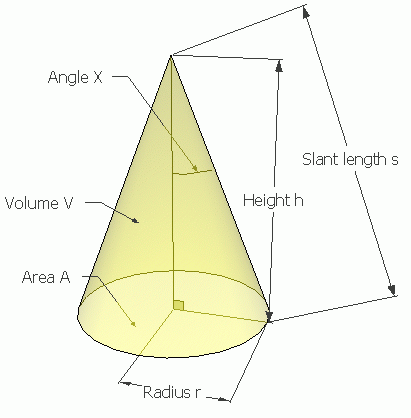| |||
| Math Central | Quandaries & Queries |
|
Question from Marija, a student: |
Lots of them.
It depends on what you know about the cone.

Here is a cone with a few things identified on it. I'm assuming you have what we call a right circular single-napped cone, which is a cone that has a circle for a base and the tip of it is centered over the circle.
The calculations mostly rely on the fact that their is a right angle at the bottom, so you can make a right triangle with the radius r, the height h and the slant s. The angle X is also in the triangle.
If you know any two things on this diagram, you can find any of the others.
For example, if you know the height h and the angle X, you can use the trig function TAN (tangent) to find the radius:
r = h tan(X).
And of course since the diameter is just twice the radius,
diameter = 2 h tan(X).
If you know want the area of a circle, it is calculated using A = π r2, so we can put the two equations together and we get this:
A = π ( h tan(X) )2.
The volume V of a cone is
V = (1/3) h A.
So if you knew the height h and the volume V and wanted the area, you would re-arrange this algebraically into:
A = 3V / h.
If you know the slant length s and the angle X, you can use the trig function SIN (sine) to find the radius r:
r = s sin(X).
And we can use this to find the area A again by combining it with A = π r2 :
A = π ( s sin(X) )2
Let's say you wanted to know the volume and all you have is the slant s and the angle X. This takes a few steps:
First find the Area A in terms of s and X, which we just did: A = π ( s sin(X) )2. Now we need h because V = (1/3) h A. But we can use the COS (cosine) function to find h if we know X and s:
h = s cos(X).
If we combine these three equations, we get:
V = (1/3) ( s cos(X) ) π ( s sin(X) )2
which will work, but we can reduce it using trig identities to:
V = [π s2 sin (2X) ] / 6.
See what else you can figure out.
Cheers,
Stephen La Rocque.
 |
||
Math Central is supported by the University of Regina and The Pacific Institute for the Mathematical Sciences.